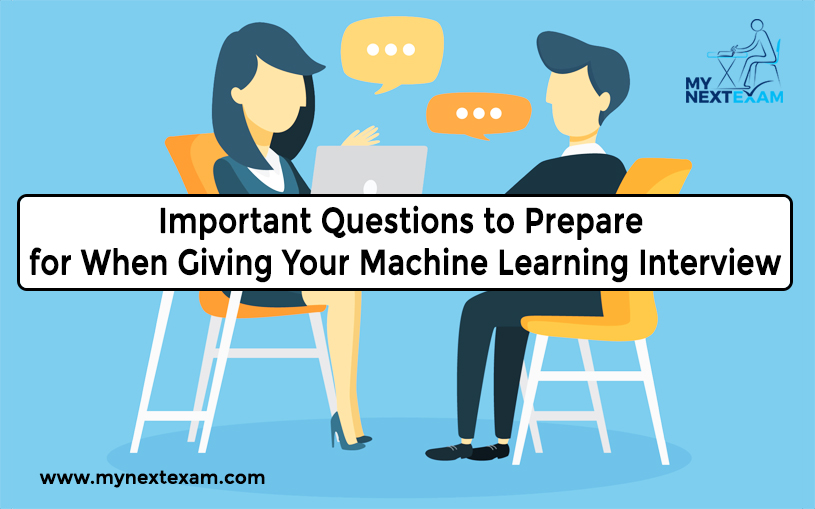The most anxiety inducing part of an interview is the questioning face where the interviewer attempts to test your depth of knowledge in your field. The difficulty of the interview questions can significantly depend on the subject of your specialization and the job you are applying for. If you are interested in applying for a data science job, the machine learning interview questions will play a significant role in whether you get the job or not. If you are looking for a one-stop guide for machine learning interview questions, here is a great one.
Categories of Machine Learning Interview Questions
Machine Learning interview questions usually come up in the following categories. Dividing them in this manner allows for a more comprehensive method to tackle them.
1. The first method actually deals with the algorithms and theoretical aspects of machine learning. The interviewer will test your understanding of various algorithms and how they compare with each other in terms of their efficiency and accuracy.
2. The second category deals mainly with your programming skills and the ability you have in executing the algorithms you have studied about.
3. The third test will mainly analyze your general interest in machine learning and will be used to determine how up-to-date you are with the latest advancements in this field.
4. The final category involves industry-related questions that test whether you can apply your knowledge of machine learning into actions that will take the company forward.
This guide will brief over the questions that will help you ace your interview. However, you will still need to research more about the questions individually to actually ace them.
1. The difference between bias and variance.
Bias is an error that occurs due to extremely simple assumptions in the learning algorithm. This can make it very hard for the algorithm to actually develop predictive accuracy.
2. The difference between supervised and unsupervised machine learning.
Supervised learning is the kind that requires labelled data for its training. On the other hand, unsupervised learning algorithms don’t require explicitly labeled training data.
3. The difference between KNN and K-Means Clustering.
The K-Nearest Neighbors is a supervised learning algorithm used in classification. On the other hand, K-Means Clustering is an unsupervised learning algorithm. Even though the mechanisms of both algorithms are very similar at first, you would be required to label the given dataset for the KNN to work.
4. Working of the ROC curve.
The ROC curve is used to graphically represent the contrasts between the rates of true and false positives at various given thresholds. You will be able to use it as a proxy for the trade-off between the sensitivity of the model of true positives and the probability of triggering a false positive.
5. Precision and Recall.
Recall is the rate of true positives which explains to number of positives claimed by your model versus the actual number of positives in the given data. Precision on the other hand, is the positive predictive value. It is used to measure the number of accurate positives that your model claims against the actual number of positives that it claims.
6. Bayes’ Theorem.
Bayes’ theorem gives the probability of an event prior to its occurrence. It is expressed as the true positive rate of a condition sample divided by the sum of the false positive rate of population and the true positive rate of a condition. It is the basis behind a branch of machine learning since it lays the foundation for the Naïve Bayes Classifier.
7. Naïve Bayes Classifier.
While the Naïve Bayes Classifier is very useful in practical applications of text mining, its fundamental assumption that all the components have independent probabilities is never truly met in real life.
8. L1 and L2 Regularization.
L2 regularization usually spreads more errors among all the terms, whereas L1 is binary and corresponds to setting a Laplacian prior om the terms. L2 sets a Gaussian Prior.
9. Your Favorite Algorithm.
This is the kind of question that will test your communication of complex and technical topics, and your ability to summarize them. You should make sure that you have a choice and that you can explain the various algorithms in a simple and elegant manner while also mentioning your favorite one.
10. Type 1 and Type 2 Errors.
Type 1 Errors are false positives while Type 2 Errors are false negatives.
11. Fourier Transform.
This is a generic method to decompose generic functions into several symmetric functions in a superposition state. It is used to find the set of cycle speeds, amplitudes, and phases in order to match a given time signal. It converts a signal from time to frequency and is a great way to extract features from audio signals and other sensor data.
12. Probability and Likelihood.
Probability is the prior knowledge of the chances of an event occurring while it hasn’t yet occurred. Likelihood is a measure of the extent to which a sample provides support for particular values of a parameter in a parametric model.
13. Deep Learning.
Deep learning is a branch of machine learning that is primarily concerned with neural networks. It involves the use of backpropagation and certain principles from neuroscience to create large models of datasets with unlabeled or semi-labeled data.
14. Generative and Discriminative Model.
A generative model will be used to learn categories of a dataset and a discriminative model would learn the differences between the different categories. Discriminative models outperform generative ones for classification tasks.
15. Time Series Dataset cross-validation.
Cross validation of a time series dataset requires you to pay attention to the fact that the data is ordered chronologically. A pattern is bound to emerge during the later years of the dataset and your model can pick up on that.
16. Decision Tree Pruning.
Pruning is something that happens to the branches of decision trees when they have weak predictive power. These are removed in order to reduce the complexity of the model while increasing its predictive accuracy. It can be done with a bottom-up and top-down approach.
17. Model Accuracy Vs. Model Performance.
Model accuracy is a mere subset of model performance and can sometimes be misleading. Therefore, it is more important to focus on the all-round performance of your model.
18. F1 Score.
This is a measure of the model’s performance and is the weighted average of the precision and recall of the model which has results tending to 1 as the best and tending to 0 as the worst.
19. Imbalanced Dataset Handling.
An imbalanced dataset is the kind that has a strong imbalance in values. The best way to handle this is to collect more data in order to even out the imbalances in the dataset. You can also resample the dataset for correction of the imbalances or try a different algorithm that would be more suited to handle the imbalance.
20. Classification over regression.
Classification is a method that can produce discrete values according to strict categories. Regression on the other hand, gives continuous results that can allow you to have a better differentiation between the points.
21. Name an example where ensemble techniques can be useful.
Ensemble techniques are the kind that use a combination of various machine learning algorithms in order to optimize better predictive performance. These are going to typically reduce the overfitting in various models and make them more robust.
22. Prevent overfitting in models.
This is a fundamental principle of machine learning which can be maintained with three methods. The first is to keep the model as simple as possible. The second requires the use of cross validation techniques. You will also need some regularization techniques like LASSO.
23. Evaluation Approaches.
To evaluate your machine learning model and gauge its effectiveness, you will be required to split the dataset into two sets – namely training and test. This also requires the use of cross-validation techniques to segment the dataset into smaller sets for the training to go smoothly.
24. Evaluation of Logistic Regression Models.
This will require you to know what the goals of a logistic regression model are and then use them to figure out the ideal evaluation approach. This may require you to bring up a few examples in your answer for extra points.
As you can see, machine learning interview questions aren’t as hard as they may sound. You can ace your interview with a solid foundation of preparation.
Also See:

















Leave a comment
Comments:
Lipi